About Tony Hyman
A very lucky guy
© Tony Hyman
About Tony Hyman
A very lucky guy
© Tony Hyman


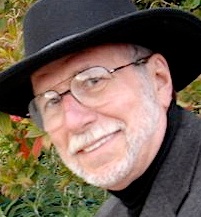
SHORT “CIGAR BIO”
The Museum began when a 12 year old boy spent a Spring Saturday collecting cigar boxes from local liquor stores, pool halls, restaurants, barber shops, and the cigar stand in our local post office. The end of the day found me with a small pile ready to help organize my childhood treasures. Noticing some boxes were made in California, some in Florida, some in Pennsylvania, and that the same brand could be packed in more than one type box, I wondered how many different cigar boxes there were.
Filled with adolescent fervor I began hounding stores for empties and over the course of three summers knocked on half the doors in a town of 18,000 trading neighbors for old boxes. Someone donated a 1951-52 Tobacco Trade Directory which listed hundreds of cigar makers, so I spent the summer of my sophomore year painfully pecking typed letters to two dozen of the larger companies. Waitt & Bond, Marsh Wheeling and RG Sullivan all responded with cigar boxes, and Sullivan’s were full! Best of all, each included a typed history of their company, giving me the researcher’s thrill of getting ‘inside info’ that isn’t available anywhere else. In late 1956 I enlisted in the Navy at age 17, the proud owner of 2,316 cigar boxes and a small but growing collection of books, catalogs and other paper.
Since then, various career choices made it possible for me to study and buy coast to coast across the U.S. and Canada, through Europe, Mexico and in Cuba. I’ve never knowingly passed up anything that might be historically important. If it taught me something, I bought. If I thought it could or would illustrate some particular point, theory, style or event, I bought it. While living in eight states, earning three degrees, and a number of quite distinct careers, cigar research has been my one constant for 60+ years. As far as I know I own the world’s largest collection of cigar packaging and historical ephemera.
Because I'm a compulsive teacher (and am married to another) I wrote The Handbook of American Cigar Boxes, The World of Smoking and Tobacco, the monthly Tobacciana column in The Antique Trader Weekly. and dozens of entries in the International Encyclopedia of Tobacco. I’ve graced the cover of Cigar Magazine and wrote columns and features for them for years.
My box collection has appeared in American Heritage, Sports Illustrated, Collector’s Showcase, Collector, Cigar Magazine, Cigar Aficionado, Smoke, Smokeshop, A.A.A.A. and numerous antiques publications. I have advised museum curators, movie prop departments, TV shows, theatrical producers and re-constructionists on matters of cigar history.
I formerly smoked Robt. Burns, bought a box of 30¢ aluminum-tubed Bering Imperials to celebrate my discharge from the Navy in 1960, and smoked various Tiparillo type cigars in the 70's. A new bride and life-changing move to NYC led me to give up smoking. When I went to Cuba in 1992 I smoked cigars from the moment I got up until the moment I crawled into bed.
I came home and quit again.
THAT'S THE CIGAR BIO.
THE REST OF LIFE WAS
MORE COMPLICATED, MORE FUN,
MORE PRODUCTIVE AND MORE DIVERSE,
More details.
After graduating from a small Southern California Catholic HS in 1956, I enlisted in the Navy which well-trained me as a draftsman and technical illustrator. Applied for a survey ship in Africa: got NAS Pensacola after which the 7th Fleet staff in Pearl Harbor where I ran day to day operations of the film library for the entire Pacific theater. The Navy taught me that a shy high-schooler could at 18 be given challenging responsibility, and lead others to completing tasks.
I liked the variety and ever growing responsibility the Navy offered and considered a career.
But I left Uncle Sam and Hawaii to follow a co-ed to Fort Collins, Colo. and my first winter ever. Colorado State (CSU) had 31 consecutive days when temperature never got above 0°; I loved my classes and papers and did well. My Dr. Hyde side got thrown out of the dorm for being a bad example to younger students by getting good grades while apparently spending my life on girls, bridge, theater and home-made beer. My most expensive college lesson was selling my California hot-rod 49 Mercury because it wouldn’t start (I didn’t know that 30 weight oil was not for 30° below).
A spontaneous 1961 marriage between two students who knew each other for only a few months didn’t work and was annulled after 5 years. On a happier note the spontaneous 1968 marriage between two students who knew each other for only four months is working great and close to it’s 50th year. Tales for another time another place.
On and off-campus anti-HUAC activities (the 1st 1960s Free-speech protest movement) got four of us in a van chased by 3 pick-up loads of righteously angry, anti-communist, gun-carrying farmers across Colorado back roads at 11:30 on a moonlit night...another story.
Out of State tuition was using up my meagre military savings faster than planned, so I worked three days a week as a draftsman at a cement company for whom I drew maps from core sample notes. After two years, the lure of $34 a semester college tuition and warm weather brought me home. Southern California smog was too much so opted to attend San Jose State in the South Bay.
My wife got a job teaching JrHi and I went to SJS full time. I loved school. I appeared in four plays, hosted a weekly folk music radio show, played a lot of poker and golf, wrote lots of op-ed pieces and letters to the editor and worked as a teaching assistant in Political Science. I was also an out-spoken free speech advocate and in the mid 60's was co-founder and three time editor of The Tower List, a 64 page 10 category rating of the best and the worst of the SJS faculty published by Tau Delta Phi the men’s scholastic honorary fraternity (an outstanding invited membership of young men of all types having in common only high GPAs and a tendency to make our opinions known). The List lasted 41 years.
In addition to student power activities, I was a member of six scholastic and service organizations, a social activist in the 60’s style and generally a pain to the authorities who weren’t fond of The Tower List but didn’t know how to legally stop us. They were glad when we graduated. SJS gave me BA with Great Distinction in Political Science, Departmental Honors and “President’s Scholar” designation. I stuck around long enough to get the fifth year training for a lifetime California HS teaching credential. As we had planned (we each worked two years while the other finished school) my first wife and I annulled the marriage and we went our separate ways.
I taught HS Sociology for three years, and during the summer trained Peace Corps volunteers on how to handle culture shock, analyze power structures, and the like. Loved teaching, was creative in content and approach, and twice voted most popular teacher on a huge 3,200 student campus. Every year my home room class collected the most food for the annual food drive.
I learned once again that I could motivate people to do good things.
I left Santa Cruz and teaching in 1968 to accept a National Science Foundation scholarship to study Sociological Data Gathering and Analysis in Chicago. The first day of school appeared fellow awardee Marilee Baldwin, whom I married four months later. Our first date was opening Gene McCarthy’s campaign head-quarters at the 1968 Democratic convention in Chicago. Our next few dates involved tear gas, police and a lot of running. My 1969 Master’s thesis dealt with hereditary brain-chemical influence on child development. Marilee wrote on riot control or lack of it at the 1968 Chicago Convention. A few stories for another day.
Marilee and I moved to NY City where I studied at Columbia University, courtesy of an NDEA scholarship. After changing majors from Sociology to Anthropology to Instructional Technology all in the first semester I graduated with a Doctorate in information manage-ment. My dissertation defined ways of teaching film and visual literacy to HS students. Columbia Teachers College held a one man show of my photography before I left to teach photography and media utilization at Ithaca college in upstate NY. I had a madman for a boss, causing me to grind my teeth nightly. Marilee insisted that unemployment was better than insanity, even with two babies to support. I agreed and quit.
Before leaving at the end of the year, a student informed me that an unbelievably rare and fabulous car I was offered in 1958 at age 18 for $600 (I was taking home $38 a month in the Navy and tried unsuccessfully for weeks to raise the asking price) had just been featured in a car magazine and sold for $80,000. Decades later, the son of the Navy man who bought it when I couldn’t, told me that it ultimately resold a few years ago for $1,700,000. Life’s filled with near-misses. Since its hot-rod Ford engine could go 160 1934 mph, I console myself with the thought It was an incredibly impractical vehicle to drive and would have been a burden not a joy to own for most of my life. Today, on the other hand...
After a few months home helping take care of two babies and the garden that was our food, the NY State Employment Office came to the rescue, discovering a 52 school rural combine in need of someone to fund, design and build “whatever we need.” Government money was plentiful and I was good at writing grants, so for three years one 1,200 square mile section of South Central New York got more grant money than any educational institution in the entire state. We built to the hilt.
My outstanding staff of 15 were so good that in ten years the library delivered and picked up 350,000 orders for books, films and other teaching aids without one lost item. During that time I annotated 10 film catalogs and co-authored a book on classroom utilization of avant-garde film and spoke at the national education convention on how libraries can maintain controversial film collections without controversy.
One $1,200,000 grant let me build a county-wide TV system involving 18 towers (tallest one at 400’), wire every classroom in the 52 county schools for two-way television, purchase 800 25” color monitors (one in every room including teacher’s lounge), and put video recorders in every school. Money went a LOT further in those days. Another $400,000 in 1975, led to the first contracts for video duplication of 16mm film for classroom purposes. Eventually a small consortium which I co-founded each owned 3,000± educational film titles on video (1979). The entire five year television project was on time and under budget (I couldn't find anything to buy with the last $34). Can you imagine trying to do all that for $1.6 million today? In 1981, my technical center became the first school-owned facility in the United States to be licensed by Apple, IBM, Commodore and Tandy (Radio Shack) as an official computer repair and warranty station and in 1984 the first to convert from 3/4” to the ‘latest’ 1/2” VHS.
Once built, I was bored and ready to move on but Marilee got one of those once-in-a-lifetime management opportunities. We stayed an additional three years while she rescued the local chapter of the Association for Retarded Children and its 225 employees and clients from being shut down bankrupt. An unbelievable story. She did for them what Lee Iacocca did for Chrysler... for a lot less money ($27,000 a year).
In 1978 the book Buffs, Mavens and Uncommon Experts featured my cigar history research. Contact with the publisher ultimately led to a contract to write our first buyer directory, Where To Sell Anything and Everything. After two editions we became convinced that we could sell more than World Almanac (my publisher) and decided to go into the publishing business. We moved to Southern California to give our 10-12 year old farm-raised sons urban experience.
In a few months selling our own 3rd edition we earned more than in six years with World Almanac, largely because we didn’t quit publicity after two weeks (the ‘big time’ practice) and found a way to reach readers instead of bookstores.
Between the 1986 release of our 3rd buyer directory and the closing down of the 10th in 2005, Talker Magazine named me "America’s hottest talk show guest" with over 2,500 appearances. Radio was great fun for me. Sit at home and chat with many of the greats: Jim Eason, Ray Breim, Roy Leonard, Paul Gonzales, Larry King...many more. And I could do it in my underwear.
The more experience I got, the more I liked doing TV. Each show became a challenge to be entertaining while selling the audience to come to a local event at which I would show them how to get best dollar for their collectibles and antiques.
It was quite an experience to work with Donahue (and save his day), Oprah (twice when she was second-banana on a Baltimore local show; I thought her name was Okra), Vicki Lawrence! (who enjoys raunchy) , Terry Bradshaw (6 shows taped, two never aired, including the day his show was canceled; Terry was unpredictable and fun), Jimmy J and Tammy Faye (an honest-to-goodness sweetie...and the ONLY appearance anywhere where 2 props disappeared), Gayle King (3 times and a broken prop), George Hamilton & Alana (I think the show lasted a week)... fun...but it does get old and boring. Fortunately, I’m naturally ready, so don’t feel a lot of pressure to be “on game.”
My 35 appearances selling on QVC are far from a record, but another unforgettable adventure. If you plan to travel near Malvern, PA, book a tour. QVC is an amazing operation with bigger and better facilities than any of the NYC or LA based networks.
When working the circuit (1980-2003) I considered writing a magazine article featuring reasons for which an appearance was cancelled. “A sniper shot our engineer in the parking lot,” “the zoo gorillas decided to mate” (with live coverage) and “the mayor’s daughter wrote a new Polish wedding song and we’re playing it all day” are among my memories.
In the late 80's I created and supervised the collectibles segment on Stacey Keach’s syndicated TV Missing Reward for three years and wrote and distributed the brochure he gave away each week. 1992 began eight years hosting Trash or Treasure, a radio call in show heard each Saturday and Sunday on 150+ stations nationwide for five hours. This led to a national lecture tour, and 50-70 talks a year around the U.S. and Canada.
In 1998, my "Secret of Barbie's Butt" teaser impressed the executive producer of CBS Network TV's Saturday Early Show enough to fly Marilee and me back and forth to NYC for 3 years to write and host a weekly antiques and collectibles segment. Shows included the history of ironing, valentines, sewing machines, bicycles, jewelry, dolls, Super Bowl tickets ... and, of course, cigar boxes. The anthrax scare ended the segment, after 100 episodes. Another story.
We began retiring in 2004 so we could travel, Marilee could continue civic activities and I could work on the Cigar Museum. She retired in 2005. I followed shortly thereafter. I had worked or been in school for 50 years, Marilee for 51.
We visited (either working or traveling) 45 states, most of Canada, various parts of Mexico, most of Europe including Scandinavia and Russia followed by Peru, Egypt, and East and South Africa. Peru and Estonia were my favorite countries, Scandinavia I could move to. Rome, Paris, London and New York all require multiple visits. An important piece of advice when planning to travel in the middle East: learn how to read “made in China” in Arabic.
I’m cranking out Museum Exhibits as fast as time and health permit.
Tony Hyman
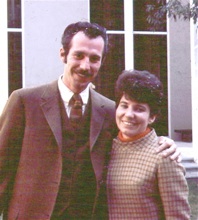
Marilee and my wedding portrait out side the USC chapel, Dec. 1968. Five relatives and two fellow school-teacher friends attended. We drove back to school in Chicago a week later in a 57 VW van with no heater.
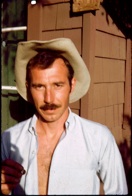
Cigar smoking HS teacher at home. Pleasure Point, Santa Cruz, CA 1966.
My box collection was in storage except
for new acquisitions. Sad tale of a 1915
$15 Pan Pacific box and a cute date.
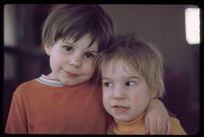
Mark and Dan followed, 1970 and 1972. Watkins Glen, NY, 1975. Forty years later Mark has an MS in Robotics; Dan a PhD in Micro-engineering. Photo: Tony
Marilee, one of the toughest, smartest, self-reliant, compassionate women I’ve had the pleasure of meeting. New York City, 1971. Photo by Tony
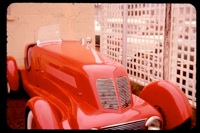
“My” 1934 Edsel roadster in 1958. For sale at $600 which I couldn’t raise. Same car later sold for more than a million bucks. One that got away. Pensacola, Fla.
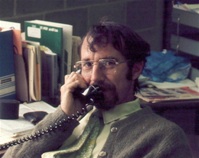
The new administrator making deals. 1975
My favorite portrait, taken by fellow library director Brian Horey at a state meeting of all 43 NY County Media Library Directors. Everyone else wore a suit. Another story.
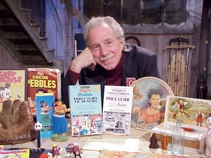
Posing before a sales pitch in the QVC garage. During the 1990’s, I appeared 35 times, and was QVC’s biggest overnight seller, not always a good thing to be.
Organic farm days, 1978. Marilee photo.
The Navy was good experience, teaching me skills I’m using to this day. I vote yes for universal military training. Photo taken Pearl Harbor Navy barracks, 1959.
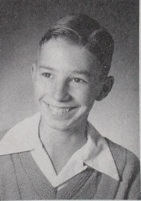
The kid who started it all.
13 year old HS freshman. 1952
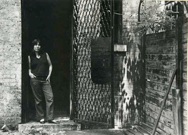
On the road again. Working the lecture tour gave us the opportunity to try the best restaurants in most of the major cities of North America. Yum. 1992
For three years on the CBS SATURDAY EARLY SHOW I was fortunate to work with Russ Mitchell & Thalia Assuras, two first rate pros who are now news anchors for CBS-TV. Here I show Thalia an exquisite selection of Christmas ornaments. Photo by Marilee 2000
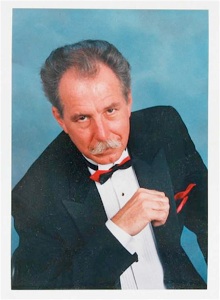
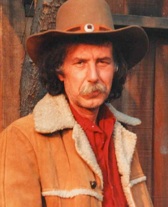
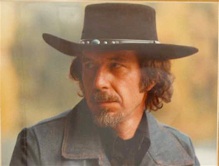
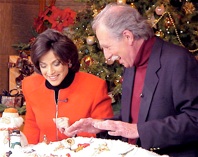
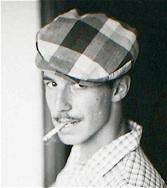
Photo: Dr. David Diaz
Photo by Marilee. 2007
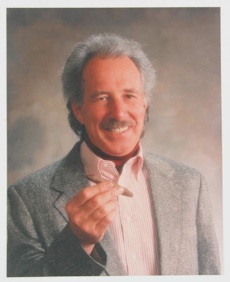
A rare moment of relaxation on the farm and job. Marilee photo, 1974